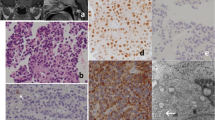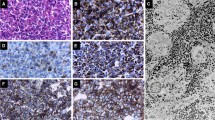Abstract
Epidermal growth factor (EGF) and epidermal growth factor receptor (EGFr) were investigated by immunocytochemistry (ICH) in 57 human pituitary adenomas and 10 nontumorous autopsy pituitaries. EGF immunoreactivity was demonstrated in 24 adenomas (42%), representing 23 functioning tumors and 1 nonfunctioning tumor of oncocytic type, and in all nontumorous pituitaries. Among 40 tumors, EGFr was found positive in 15 functioning adenomas (37.5%), representing 50% of them. The presence of both EGF and EGFr was found mainly in corticotroph adenomas (60%) and less frequently in somatotroph and lactotroph adenomas (20%). ICH on serial sections with EGF or EGFr and adrenocorticotrophic hormone (ACTH) or S-100 protein revealed that EGF and EGFr are localized specifically in corticotrophs and EGFr in stellate cells of nontumorous adenohypophysis.
These results confirm the presence of EGF and EGFr in human pituitary adenomas and nontumorous pituitaries and highlight their frequent occurrence in hormone-producing adenomas. Further work is required to explore the possibility that EGF and EGFr play a role in hormone production, release, and tumor progression.
Similar content being viewed by others
References
Sporn MB, Todaro GJ. Autocrine secretion and malignant transformation of cells. N Engl J Med 303:873–880, 1980.
Kasper S, Friesen HG. Growth factors: a selected review. In: Lüdecke DK, Tolis G, eds. Growth hormone, growth factors and acromegaly. New York: Raven, 1987; 67–77.
Webster J, Ham J, Bevan JS, Scanlon MF. Growth factors and pituitary tumors. Trends Endocrinol Metab 48:95–98, 1989.
Kontogeorgos G, Kovacs K, Scheithauer BW. Growth factors in the pituitary gland. Endocr Pathol 5:1–3, 1994.
Johnson LK, Baxter JD, Viodavsky L, Gospodarowicz D. Epidermal growth factor and expression of specific genes. Effects on cultured rat pituitary cells are dissociable from the mitogenic response. Proc Natl Acad Sci USA 77:394–398, 1980.
Schonbrunn A, Krasnoff M, Westendorf JM, Tasjian AH Jr. Epidermal growth factor and thyrotropin-releasing hormone act similarly on a clonal pituitary cell strain. Modulation of hormone production and inhibition of cell proliferation. J Cell 85:786–797, 1980.
Ikeda HT, Mitsuhashi K, Kubota K, Kuzuya N, Ucimura H. Epidermal growth factor stimulates growth hormone secretion from superfused rat adenohypophyseal fragments. Endocrinology 115:556–558, 1984.
Yajima Y, Saito T. The effects of epidermal growth factor on cell proliferation and prolactin production by GH3 rat pituitary cells. J Cell Physiol 120:249–256, 1984.
Melmed S. Pituitary growth factors. In: Scanlon MF, Wass JAH, eds. Neuroendocrine perspectives. vol 6. New York: Springer-Verlag, 1986; 27–40.
Zapf J, Froesch ER. Insulin-like growth factors/somatomedins. In: Lüdecke DK, Tolis G, eds. Growth hormone, growth factors and acromegaly. New York: Raven, 1987; 85–93.
Kasselberg AG, Orth DN, Gray ME, Stahlman MT. Immunocytochemical localization of human epidermal growth factor/urogastrone in several human tissues. J Histochem Cytochem 33:315–322, 1985.
Alberti VN, Takita LC, de-Moskita MI, Peracio S, Maciel RM. Immunohistochemical demonstration of insulin-like growth factor I (IGF-I) in normal and pathological human pituitary glands. Pathol Res Pract 187:541, 542, 1991.
Halper J, Parnell PG, Carter BJ, Ren P, Scheithauer BW. Presence of growth factors in human pituitaries. Lab Invest 66:639–645, 1992.
Driman DK, Kobrin MS, Kudlow JE, Asa SL. Transforming growth factor-α in normal and neoplastic human endocrine tissues. Hum Pathol 23:1360–1365, 1993.
Pen R, Med B, Scheithauer BW, Halper J. Immunohistochemical localization of TGF-α, EGF, IGF-1, TGF-β in human normal pituitary glands. Endocr Pathol 5:40–48, 1994.
Doolittle RF, Hunkapiller MW, Hood LE, Devare SG, Robbins KC, Aaronson SA, Antoniades HN. Simian sarcoma virus oncogene, v-sis, is derived from the gene (or genes) encoding a platelet-derived growth factor. Science 221:275–277, 1983.
Carpenter G, Zendergui JG. Epidermal growth factor, its receptor and related proteins. Exp Cell Res 164:1–10, 1986.
Gill GN, Bertics PJ, Santon JB. Epidermal growth factor and its receptor. Mol Endocrinol 51:169–186, 1987.
Fisher DA, Lakshmanan J. Metabolism and effects of epidermal growth factor and related factors in mammals. Endocr Rev 11:418–442, 1990.
Chabot JG, Walker P, Pelletier G. Distribution of epidermal growth factor binding sites in the adult rat anterior pituitary gland. Peptides 7:45–50, 1986.
Chaidarun SS, Eggo MC, Sheppard MC, Steward PM. Expression of epidermal growth factor (EGF), its receptor, and related oncoprotein (erb B-2) in human pituitary tumors and response to EGFin vitro. J Clin Endocrinol Metab 135:2012–2021, 1994.
Krämer A, Saeger W, Tallen G, Lüdecke DK. DNA measurement, proliferation markers, and other factors in pituitary adenomas. Endocr Pathol 5:198–211, 1994.
Kontogeorgos G, Kovacs K, Scheithauer BW. Null cell adenomas, oncocytomas and gonadotroph adenomas: an immunocytochemical analysis of 300 cases. Endocr Pathol 4:20–27, 1993.
Ozanne B, Richards CS, Hendler F, Burns D, Gusterson B. Overexpression of the EGF receptor is a hallmark of squamous cell carcinomas. J Pathol 149:9–14, 1986.
Gullick WJ. Prevalence of aberrant expression of the epidermal growth factor receptor in human cancers. Br Med Bull 47:87–98, 1991.
Aanestad M, Rotnes JS, Torjiesen PA, Haug E, Sand O, Bjoro T. Epidermal growth factor stimulates the prolactin synthesis and secretion in rat pituitary cells in culture (GH4C1 cells) by increasing the intracellular concentration of free calcium. Acta Endocrinol 128:361–366, 1993.
Altschuler LR, Parisi MN, Cageao LF, Chiocchio SR, Fernandez-Pol JA, Zaninovich AA. Epidermal growth factor stimulates thyrotropin secretion in the rat. Neuroendocrinology 57:23–27, 1993.
Gilchrist CA, Shull JD. Epidermal growth factor induces prolactin mRNA in CH4C1 cells via a protein synthesis-dependent pathway. Mol Cell Endocrinol 92:201–206, 1993.
Rakowicz-Sulcznska EM, Otwiaska D, Rodack U, Koprowski H. Epidermal growth factor (EGF) and monoclonal antibody to cell surface EGF receptor bind to the same chromatin receptor. Arch Biochem Biophys 268:456–464, 1989.
van’t Hof RJ, Defize LH, Nuijdens R, de Brabander M, Verkij AJ, Boonstra J. Dynamics of epidermal growth factor receptor internalization studies by Nanovid light microscopy and electron microscopy in combination with immunogold labelling. Eur J Cell Biol 48:5–13, 1989.
Birman P, Michard M, Li JY, Peillon F, Bression D. Epidermal growth factor binding sites, present in the normal human and rat pituitaries, are absent in human pituitary adenomas. J Clin Endocrinol Metab 65:275–281, 1987.
Todderud G, Carpenter G. Epidermal growth factor: the receptor and its function. Biofactors 2:11–15, 1989.
Schlesinger J. The epidermal growth factor receptor as a multifunctional allosteric protein. Biochemistry 27:3119–3123, 1988.
Damjanov I, Mildner B, Knowles BB. Immunohistochemical localization of the epidermal growth factor receptor in normal human tissues. Lab Invest 55:588–592, 1986.
Author information
Authors and Affiliations
Rights and permissions
About this article
Cite this article
Kontogeorgos, G., Stefaneanu, L., Kovacs, K. et al. Localization of epidermal growth factor (EGF) and epidermal growth factor receptor (EGFr) in human pituitary adenomas and nontumorous pituitaries: An immunocytochemical study. Endocr Pathol 7, 63–70 (1996). https://doi.org/10.1007/BF02739916
Issue Date:
DOI: https://doi.org/10.1007/BF02739916




